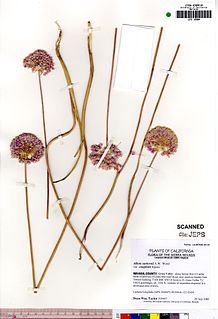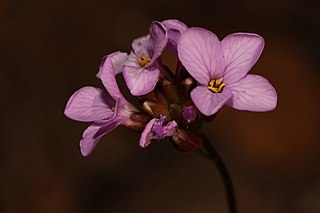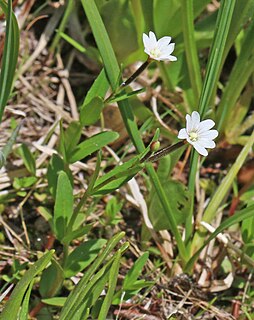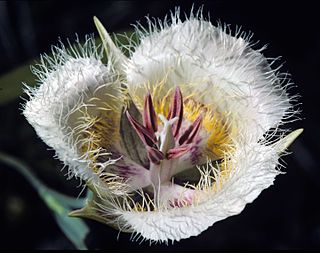
Epilobium is a genus of flowering plants in the family Onagraceae, containing about 197 species. The genus has a worldwide distribution. It is most prevalent in the subarctic, temperate and subantarctic regions, whereas in the subtropics and tropics Epilobium species are restricted to the cool montane biomes, such as the New Guinea Highlands.

Chamaenerion is a genus of flowering plants in the family Onagraceae. It has sometimes been included in the genus Epilobium. Members of the genus may be called willowherbs, or fireweeds, based on a common name used for C. angustifolium. They are upright herbaceous perennials, growing from a woody base or from rhizomes, with racemes of usually purple to pink flowers. All species are found in the northern hemisphere. Most occur in moist habitats; C. angustifolium is the exception, favouring disturbed ground.

Epilobium septentrionale, with the common names Humboldt County fuchsia and northern willowherb, is a species of willowherb. Like the wildflower zauschneria, this plant was once treated as a member of genus Zauschneria but has more recently been placed with the willowherbs.

Geranium oreganum is a species of geranium known by the common name Oregon cranesbill, or Oregon geranium. It is native to western North America from California to Alberta, where it grows in mountain forests and meadows. This is a perennial herb growing generally erect to heights of 40 to 80 centimeters. The slender stems have a foliage of large palmate leaves up to 15 centimeters wide and divided into several segments, each of which is subdivided into rounded or pointed lobes. The flower has pointed sepals beneath rounded lavender to purple petals. The fruit has a small body with a pointed style column up to five centimeters long.

Helianthus bolanderi is a species of sunflower known by the common names Bolander's sunflower and serpentine sunflower. It is native to California and Oregon, where it grows mainly in mountainous areas, often in serpentine soils. It has been found from southwestern Oregon as well as in northern and central California as far south as Santa Cruz County, with reports of a few isolated populations in southern California.

Allium sanbornii is a North American species of wild onion known by the common name Sanborn's onion. It is native to northern California and southwestern Oregon. It grows in the serpentine soils of the southern Cascade Range and northern Sierra Nevada foothills.

Arabis aculeolata is a species of flowering plant in the mustard family known by the common name Waldo rockcress. It is native to a small range in the mountains of southern Oregon, where it is an uncommon member of the serpentine soils flora. Reports of its occurrence in Del Norte County, California are unconfirmed.
Arnica cernua is a species of arnica known by the common name serpentine arnica. It is native to the Klamath Mountains of northern California and southern Oregon, where it is a member of the serpentine soils flora.

Epilobium clavatum is a species of flowering plant in the evening primrose family known by the common names talus willowherb and clavatefruit willowherb. It is native to western North America from Alaska to northern California to Colorado, where it grows in rocky high mountain habitat such as talus. It is a clumping perennial herb forming bristly mounds up to about 20 centimeters high and spreading outward via tough stolons. The oval-shaped leaves are 1 to 3 centimeters long. The inflorescence is an erect raceme of flowers, each with four small pink petals. The fruit is a capsule up to 4 centimeters long.
Epilobium foliosum is a species of flowering plant in the evening primrose family known by the common names leafy willowherb and California willowherb. It is native to parts of western North America from British Columbia through California to Arizona, where it grows in many types of habitat, including disturbed areas.
Epilobium howellii is an uncommon species of flowering plant in the evening primrose family known by the common names Yuba Pass willowherb and subalpine fireweed. It is endemic to the High Sierra Nevada of California, where it is known from only about 20 occurrences.

Chamaenerion latifolium is a species of flowering plant in the evening primrose family known by the English common names dwarf fireweed and river beauty willowherb. It has a circumboreal distribution, appearing throughout the northern regions of the Northern Hemisphere, including subarctic and Arctic areas such as snowmelt-flooded gravel bars and talus, in a wide range of elevations. This is a perennial herb growing in clumps of leaves variable in size, shape, and texture above a woody caudex. The leaves are 1 to 10 centimeters long, lance-shaped to oval, pointed or rounded at the tips, and hairy to hairless and waxy. The inflorescence is a rough-haired raceme of nodding flowers with bright to deep pink, and occasionally white, petals up to 3 centimeters long. Behind the opened petals are pointed sepals. The fruit is an elongated capsule which may exceed 10 centimeters in length.

Epilobium oregonense is a species of flowering plant in the evening primrose family known by the common name Oregon willowherb. It is native to western North America from British Columbia to Arizona, where it generally grows in moist places in several types of habitat. It is a perennial herb growing spindly erect stems approaching 40 centimeters high or sometimes forming mats spreading via stolons. The small leaves are rounded near the base of the plant and linear in shape farther up the stem. The inflorescence bears flowers with four white to pink petals each a few millimeters long. The fruit is an elongated capsule up to 5 centimeters in length which is borne on a long pedicel which may be longer than the capsule itself.
Epilobium pallidum is a species of flowering plant in the evening primrose family known by the common name largeflower spike-primrose. It is native to western United States, where it grows in moist areas in northern California, Oregon, and Idaho. It is an annual herb producing a narrow, upright stem up to 60 centimeters long lined with narrow oval leaves each up to 5 centimeters in length. The inflorescence atop the stem bears several flowers and hairy, leaflike bracts. Each flower has four bilobed petals each up to about a centimeter long and bright pink in color. The fruit is a beaked capsule between 1 and 2 centimeters long containing a row of tiny seeds.
Epilobium rigidum is an uncommon species of flowering plant in the evening primrose family known by the common names stiff willowherb and Siskiyou Mountains willowherb.

Epilobium siskiyouense is a rare species of flowering plant in the evening primrose family known by the common names Siskiyou willowherb and Siskiyou fireweed.

Lewisia oppositifolia is a rare species of flowering plant in the family Montiaceae known by the common name opposite-leaf lewisia. It is native to the Klamath Mountains of Josephine County, Oregon, and Del Norte County, California, where it is a local serpentine endemic generally found in moist areas. This is a perennial herb growing from a small taproot and caudex unit. It produces a basal rosette of several lance-shaped, blunt-tipped fleshy leaves up to 11 centimeters long. There are sometimes smaller leaves located on the lower stem. The inflorescence is made up of one or more erect stems up to about 20 centimeters long, each bearing 1 to 6 flowers. The flower has 8 to 11 white to pale pink petals with blunt or jagged tips, each between 1 and 2 centimeters long. At the center are several stamens with pale anthers. This plant has a limited distribution and it is threatened by human activity in the area, such as logging.

Phacelia corymbosa is a species of flowering plant known by the common name serpentine phacelia. It is native to the mountains of southern Oregon and northern California, where it grows in serpentine soils.
Silene serpentinicola is a rare species of flowering plant in the family Caryophyllaceae known by the common name serpentine Indian pink and serpentine catchfly.

Calochortus coxii is a rare species of flowering plant in the lily family known by the common names Cox's mariposa lily and crinite mariposa lily. It is endemic to Oregon in the United States, where it is known only from Douglas County.















